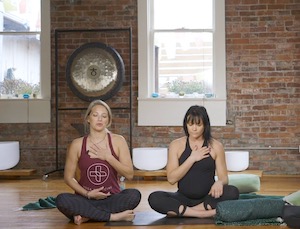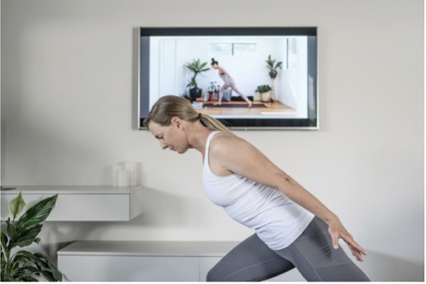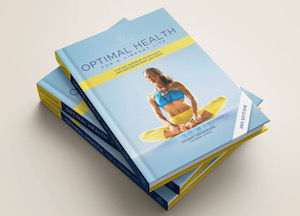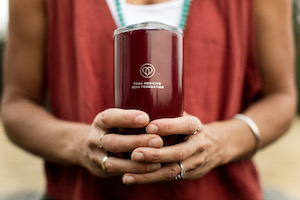Anatomy, Articles, Chinese Medicine, In the Press, Resources, Yoga Medicine® News
Self Care in Healthcare
By Leah Deutsch for Yoga Medicine®.

As a doctor of obstetrics and gynecology, I took a rather unconventional path to arrive at my healthcare profession. In the UK, the traditional route to a medical degree is a 5-6 year track, however, I diverged from that track with a bachelors degree in law, international travel, and serving on a child protection team before embarking on a graduate entry medical degree. Despite this meandering path, I always knew I wanted to work in obstetrics and gynecology (O&G) because it’s an incredibly diverse specialty where you need the deductive skills of a medic combined with the technical prowess of a surgeon. Add to that a thrill seeking behavior of an adrenaline junkie and you have the perfect O&G doctor!
Acclimating to Stress in the Medical Profession
Although I took time to ensure I was ready to commit to this career path, I wasn’t prepared for the magnitude of stress encountered in each day. The thing that you don’t really realize until you are thigh deep is while caring for a generally young and healthy population, anyone can become life threateningly unwell at a moment’s notice. The increasing seniority in women’s care further increases the amount of personal responsibility laid on the shoulders of an O&G doctor. When you add in the impact on personal health, such as the increased risk of breast, gastrointestinal, and prostate cancers 1 from working night shifts and a chronically understaffed system, it sometimes makes you wonder why anyone chooses this career! Don’t get me wrong — when the outcomes are positive it is one of the most rewarding and privileged jobs to have. It’s moments when you are faced with a mum or baby dying or having life-changing outcomes that accumulatively take their toll on a doctor’s mental and physical health.
A Pathway to Burnout
My own journey in O&G involved a few rather traumatic events during the first three years. In my first year, I was involved in two maternal deaths and an intrapartum still birth (babies dying prior to labor is about 3.74 in 1000, while in labor is far rarer around 0.32 in 1000). 4 Sadly, these events are arguably more common than necessary in the developed world. These are healthy women who come into the hospital but either they or their baby died from complications in labor.
During my second year of training, a baby died following a caesarean section I performed. I can still close my eyes and remember trying to hold it together, while suturing the woman’s shaking abdomen as she sobbed beneath me. The case went to the Coroner’s Court and I spent most of my third year of training waiting for my day in court. The verdict was that the medical team was not at fault, but the year of stress and worry had already taken its toll on me. By my fourth year of training, I was waking in the middle of the night, unable to sleep and dreading work. I began to experience a complete lack of connection and in some cases, resentment towards my patients. I had nothing left for the people close to me in my life. I was suffering from burnout.
PTSD within Obstetrics and Gynecology
In my field we have a 30% attrition rate. These are not young and disillusioned medical students having a change of heart, but rather professionals who could be 7-8 years into their careers that ultimately decide their livelihoods are unsustainable.
Professor Pauline Slade from the University of Liverpool has done extensive research into the burnout of healthcare workers. 2 In her 2019 study forthcoming in the British Medical Journal, Professor Slade identified that 1 in 10 O&G doctors suffer from clinical symptoms of PTSD and 1 in 5 from subclinical symptoms. 3 When I first heard that statistic, I needed a moment to let it sink in. I felt a mix of utter sadness that such an incredible percentage of my colleagues are suffering and also experiencing a feeling of inevitability; somehow I was unsurprised given my own experience. I realized this was not ‘feeling a bit stressed’ — this is PTSD!
A Path to Yoga
I first discovered yoga in 2001, though it was not a significant part of my life at that juncture. During medical school yoga grew in prominence as a handy relief from academic stress; but like many, my initial focus was largely on the physical practice. There was no one light bulb moment for me, but a gradual understanding of the deeper self-connection I gained by stepping on the mat. I slowly immersed myself further, not really knowing why but realizing it served to replenish my depleted self.
As I embarked on my career in O&G and began to experience these early symptoms of burnout, I found myself turning more frequently to my yoga practice. It was a kind of lifeline, a moment where I could focus inwards to who I was away from my role as a caregiver and doctor. Eventually, yoga permitted me to cultivate a stillness and a connection to being present for the first time. It didn’t remove the environment I had to work in, but it did create a kind of pause button. It enabled me to see what was important and I started to notice that I was able to curate these moments of presence away from the mat too. I found myself using pranayama and mindfulness techniques while caring for women in labor and I slowly rediscovered a passion in caring for these patients. Incredibly, I found that I began to feel less drained and even more energized with feelings of positivity from being able to connect with my patients when I took a more holistic approach to their care.
Yoga as a Tool for Lifelong Learning
In 2014, I decided to embark on a yoga teacher training due to the inspiration from what I saw yoga was bringing to both my patients and myself. Always the scientist, I felt compelled to understand what was going on at a deeper level with my practice. This was to be something purely for my own personal growth and development, but it ended up shifting my entire perspective. On my return, from a 3-week intensive training, I took steps to negotiate a reduction in my hours at the hospital, meaning I had one day a week, which was reserved entirely for yoga.
Subsequent trainings over the past five years in prenatal yoga, pranayama, and meditation have led to a continued and hopefully life long enquiry in to my practice, widening my focus to include these more subtle benefits alongside my physical yoga practice. By teaching prenatal yoga, I have gained a great personal reward in bringing these tools to women in my community which supplements their care in a very different way than in my role as a doctor.
East Meets West – Addressing the Issues
Historically, the culture fostered by the medical profession has embraced almost a militant-like detachment. Admittedly, this mental functionality serves a valid purpose in the heat of an emergency; however, it does medical professionals a disservice when processing these very real and often traumatic experiences that can manifest into burnout and high attrition rates. In recent years, there has been a gradual movement to support the wellbeing of healthcare workers and a recognition that this antiquated ‘tough it out’ mentality needs to be reworked.
The fact that yoga encompasses moving, breathing, and ‘being’ in a mindful way means to me that yoga is accessible to so many regardless of physical capacities. The use of yoga’s mindfulness tools that activate the parasympathetic nervous system and ease the mind-body disconnect can potentially provide a cheap and accessible source of healing.
Doctors are beginning to advocate for a fundamental change in how we support each other. This is reinforced by research confirming what as health care professionals we already experientially know. A 2018 randomized controlled trial showed a significant reduction in depression, anxiety, and perceived stress scores (63%, 58%, 40% respectively) in workers practicing mindfulness based techniques. 5 These scores were maintained in 3 and 6 months follow ups.
My own personal experience echoes these findings and I know anecdotally that many others feel the same. It is an exciting area of change and I passionately believe that by acknowledging the relevance of this ancient practice in treating modern day symptomatology, we could create a more resilient and compassionate medical workforce. As a society there needs to be more of a discussion in remedying a culture responsible for decades of damage and a shift to caring for the care takers.
References
1. IARC Monographs Vol 124 group. Carcinogenicity of night shift work. Lancet Oncol 2019; 20: 1058–59.
2. A programme for the prevention of post-traumatic stress disorder in midwifery (POPPY): indications of effectiveness from a feasibility study Slade, P, Sheen, KS, Collinge, S, Butters, J and Spiby, H (2018) A programme for the prevention of post-traumatic stress disorder in midwifery (POPPY): indications of effectiveness from a feasibility study. European Journal of Psychotraumatology, 9. ISSN 2000-8198
3. The implications of traumatic work-related perinatal experiences for obstetricians and gynaecologists: findings from the INDIGO study. Paper presented to World Congress of Obstetricians and Gynaecologists June 2019 Professor Pauline Slade, Institute of Health and Life Sciences, University of Liverpool
4. Healthcare Quality Improvement Partnership (2018) MBRRACE-UK Perinatal Mortality Surveillance Report 2018. Available from: https://www.hqip.org.uk/resource/mbrrace-uk-perinatal-mortality-surveillancereport-2018
5. The Effects of an Online Mindfulness Intervention on Perceived Stress, Depression and Anxiety in a Non-clinical Sample: A Randomised Waitlist Control Trial, D Querstret, M Cropley, C Fife-Schaw INTERNATIONAL JOURNAL OF BEHAVIORAL MEDICINE 23, S54-S55












